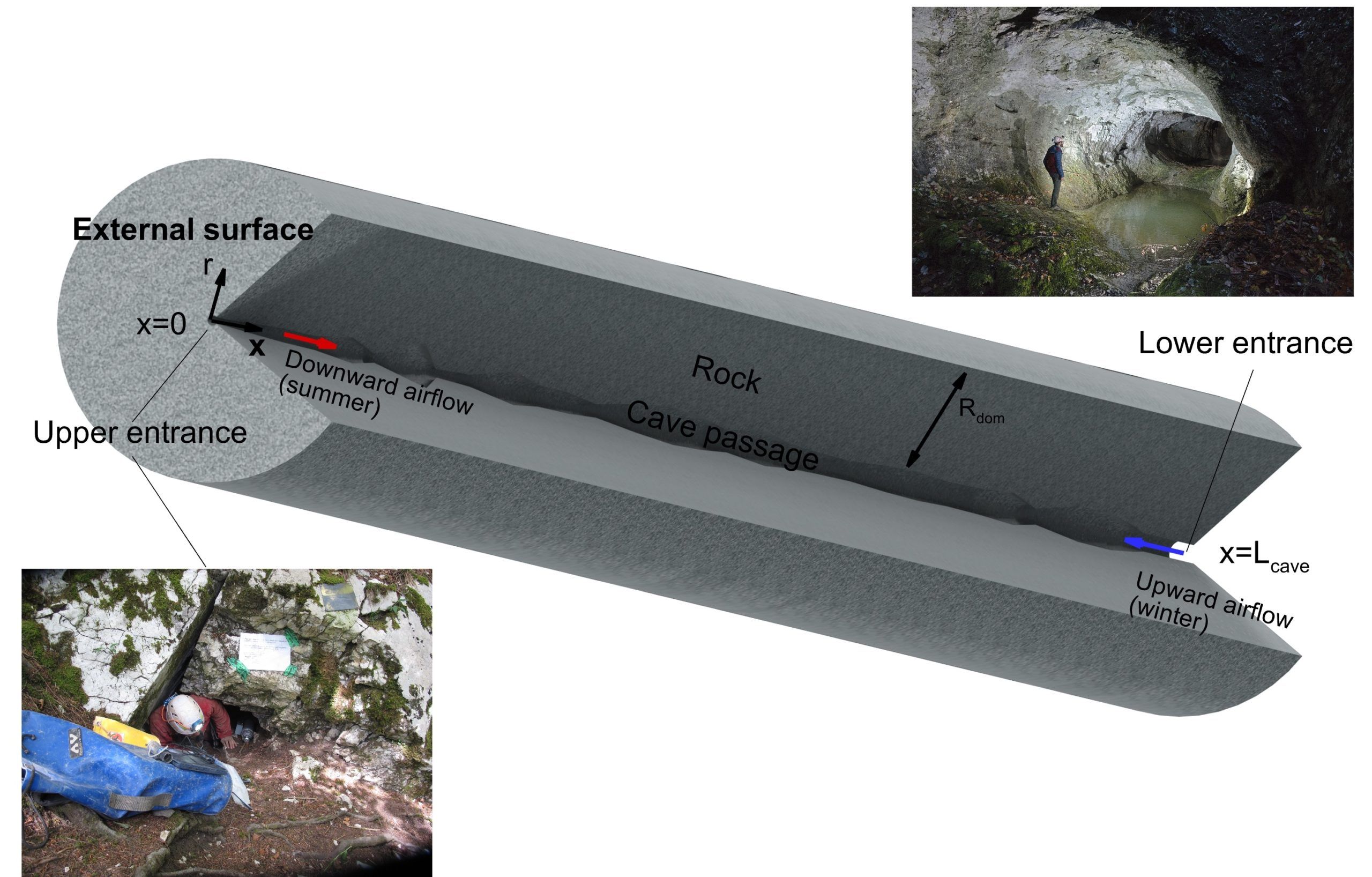-
Subterranean biology (underground biotopes),
-
Cave genesis (condensation corrosion),
-
Permafrost studies (natural ice caves),
-
Cave conservation (protection of archaeological and show caves),
-
Carbon cycle research (carbonate dissolution and precipitation are controlled by pCO2, and thus by ventilation),
-
Drinking water supply (temperature variations in karst springs),
-
Low-temperature geothermal systems (effects of conduits on heat exchange),
-
Tunneling and mining (prediction of voids and massive water inflows),
-
Public health (radon exhalation in dwellings)...
ThermoKarst
funded by the Swiss Research foundation, SNF, 2020-2024
Subterranean cavities constitute a fragile ecosystem in which biogeochemical processes are strongly dependent on temperature, humidity, and ventilation. They also preserve unique traces of their past environments.
Since the beginning of the 21st century, paleoenvironmental studies of speleothems — secondary carbonate formations such as stalagmites and flowstones — have made it possible to reconstruct the Earth’s climate with remarkable accuracy over roughly the last 0.5 million years.
However, the question of how the underground climate responds to variations in the external climate remains only partially resolved. Results of Thermokarst project show that the transfer of external temperature variations by thermal diffusion through rock is not the sole mechanism responsible for the temperature changes observed underground.
A clear understanding of the thermal response of karst systems to climate change is therefore essential to quantify dissolution and precipitation rates, interpret geochemical variations observed in speleothems, and assess the impacts on living organisms in caves.
Based on the existing literature, we have formulated three hypotheses that we aim to test in this project :
-
Ventilation within karst massifs represents a dominant mechanism for heat transfer ;
-
The response time of karst massifs and caves depends primarily on advective fluxes (of air and water), rather than on heat conduction through rock ;
-
Thermal exchanges are sufficient to generate a significant amount of condensation water capable of recharging karst systems — at least under certain conditions.
To achieve this objective, the project relies on two teams with complementary expertise: one specializing in the monitoring and conceptualization of karst systems (ISSKA), and the other in heat and mass transfer (FAST, Fluid Mechanics Laboratory, University of Paris-Sud).
Our research focused on ventilated caves, historically the least understood component of thermal transport in karst environments (since heat conduction in rock and heat advection by water had already been addressed in previous studies). The research combined empirical and theoretical approaches, producing two PhD theses1 2 and several peer-reviewed articles.
Main advances of Thermokarst project (selected) :
-
A major methodological bottleneck — the measurement of airflow in caves — was overcome through the development and validation of a robust instrument, specifically designed for underground conditions, enabling broader deployment with reasonable effort 3 4. This opens the way for systematic ventilation studies across multiple sites.
-
We demonstrated that thermal air–rock coupling leads to significant deviations from a “classical” model that considers only heat conduction through rock.
-
We defined and quantified the convection length — the distance along a ventilated conduit required to damp external temperature signals — and highlighted its dependence on the duration of climatic cycles (daily, annual, or longer) 6.
-
We established a formula linking the maximum annual convection length to airflow rate and conduit diameter.
-
We identified the decisive role of ventilation intensity on the convection length, which is itself limited by the narrowest passages within the underground conduits.
-
We described and modeled zones within caves that exhibit temperatures higher or lower than the “normal” temperature — that is, the mean annual outside air temperature at the same altitude.
-
We revised and redefined the terms heterothermic zones and homothermic zones, which are widely used in subterranean climatology.
-
We showed that chimney effects can trigger extensive and significant ventilation in underground systems when temperature contrasts exist.
-
However, we observed that ventilation intensities are often low due to narrow passages, and frequently asymmetric — with different aeraulic resistance between winter and summer — explained by local geometry (Tesla-valve behavior), gravitational effects in L-shaped systems, and other factors.
-
We identified and characterized air–rock heat exchanges along ventilated conduits.
-
We confirmed the essential role of outside temperature as a boundary condition, but noted that the average ground temperature at ~0.5 m depth is often higher than the air temperature measured 2 m above ground.
-
We clarified the role of thermal conduction within rock, acting primarily at short (daily) and long (decadal) timescales.
-
We assessed heat exchanges within the epikarst, involving both air–rock and water–rock thermal transfers.
-
We demonstrated that certain widely cited models of geothermal heat drainage at the base of karst systems are inconsistent with some theoretical aspects and with our data, indicating the need for model improvements.
Results and publications
Beyond the two theses1 2 , Thermokarst has produced several papers in international journals 3 4 5 6 7 8 with at least two additional manuscripts currently in preparation. These results identify and quantify the relevant processes (heat conduction, water advection, air convection), demonstrate how to effectively instrument caves, and lay the groundwork for integrated modeling.
Thus, the results of this project represent a key step in understanding heat transfer in carbonate rocks. The main elements required to comprehend heat transfer in karst massifs are now in place. Through a new future project, we aim to integrate the most relevant processes into a unified model at the scale of karst massifs.
The project’s findings already provide essential data for understanding the underground climate, with results also valuable for other domains:


PHD Students
PIs
Pierre-Yves Jeannin (SISKA), Frédéric Doumenc (Sorbonne), Marc Luetscher (SISKA).
Publications
1 Sedaghatkish, A. The Role of Convective Heat and Mass Transfer in the Thermal Response of Karst Conduits. PhD-Thesis, University of Neuchâtel, Centre of Hydrogeology and Geothermics (CHYN), Switzerland, 2025.
2 Pastore, C. Ventilation Dynamics and Heat Exchange in Caves: An Integrated Monitoring and Modeling Approach. PhD-Thesis, University of Neuchâtel, Centre of Hydrogeology and Geothermics (CHYN), Switzerland, 2025.
3 Pastore C., Sedaghatkish A., Schmid N., Weber E., Luetscher M., 2024. Monitoring air fluxes in caves using digital flow meters. International Journal of Speleology, 53, 63-73.doi.org/10.5038/1827-806X.53.1.2500
4 Pastore C., Weber E., Doumenc F., Jeannin PY., Luetscher M., 2024. Dispersion of artificial tracers in ventilated caves. International Journal of Speleology, 53(1), 51-62. doi.org/10.5038/1827-806X.53.1.2497
5 Sedaghatkish A., Doumenc F., Jeannin PY., Luetscher M., 2024. Modeling the effect of free convection on permafrost melting rates in frozen rock-clefts. The Cryosphere, 18, 4547–4565, doi.org/10.5194/tc-18-4547-2024
6 Sedaghatkish A., Pastore C., Doumenc F., Jeannin PY., Luetscher M., 2024. Modelling heat transfer for assessing the convection length in ventilated caves. Journal of Geophysical Research: Earth Surface, 129, e2024JF007646. doi.org/10.1029/2024JF007646
7 Sedaghatkish, A., Pastore C., Doumenc F., Jeannin P.-Y., et Luetscher M.. Thermal Modeling of Caves Ventilated by Chimney Effect. International Journal of Thermal Sciences 212 (June 2025): 24. https://doi.org/10.1016/j.ijthermalsci.2025.109757.
8 Garagnon J., Luetscher M., Weber E., 2022. Ventilation regime in a karstic system (Milandre Cave, Switzerland). Karstologia Mémoires, 23, 18-19


